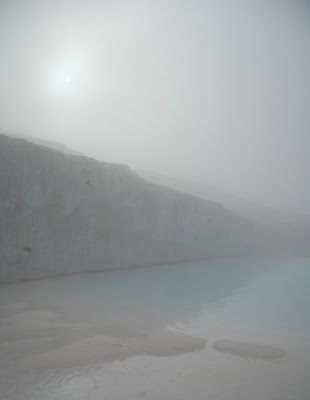PAMUKKALE
Wiki: "Pamukkale, meaning "cotton castle" in Turkish, is a natural site in Denizli Province in southwestern Turkey. The city contains hot springs and travertines, terraces of carbonate minerals left by the flowing water. It is located in Turkey's Inner Aegean region, in the River Menderes valley, which has a temperate climate for most of the year.
The ancient Greco-Roman and Byzantine city of Hierapolis was built on top of the white "castle" which is in total about 2,700 metres (8,860 ft) long, 600 m (1,970 ft) wide and 160 m (525 ft) high. It can be seen from the hills on the opposite side of the valley in the town of Denizli, 20 km away.
Tourism is and has been a major industry. People have bathed in its pools for thousands of years. As recently as the mid-20th century, hotels were built over the ruins of Hierapolis, causing considerable damage. An approach road was built from the valley over the terraces, and motor bikes were allowed to go up and down the slopes. When the area was declared a World Heritage Site, the hotels were demolished and the road removed and replaced with artificial pools. Wearing shoes in the water is prohibited to protect the deposits.The ancient Greco-Roman and Byzantine city of Hierapolis was built on top of the white "castle" which is in total about 2,700 metres (8,860 ft) long, 600 m (1,970 ft) wide and 160 m (525 ft) high. It can be seen from the hills on the opposite side of the valley in the town of Denizli, 20 km away.
Pamukkale's terraces are made of travertine, a sedimentary rock deposited by water from the hot springs.
In this area, there are 17 hot water springs in which the temperature ranges from 35 °C (95 °F) to 100 °C (212 °F).[citation needed] The water that emerges from the spring is transported 320 metres (1,050 ft)[citation needed] to the head of the travertine terraces and deposits calcium carbonate on a section 60 to 70 metres (200 to 230 ft) long covering an expanse of 24 metres (79 ft) to 30 metres (98 ft). When the water, supersaturated with calcium carbonate, reaches the surface, carbon dioxide de-gasses from it, and calcium carbonate is deposited. The depositing continues until the carbon dioxide in the water balances the carbon dioxide in the air.[citation needed] Calcium carbonate is deposited by the water as a soft jelly,[citation needed] but this eventually hardens into travertine."
Morning View
Blue water
(with high concentration of calcium carbonate)
Feeling the water running through our legs
Love walking on the travertine.
Nice..
Interesting & beautiful Landscape
Haven't seen anything like this before.
Patterns
When it gets foggy... I could see the sun!
This is the older portion where the water is not flowing anymore.
It is an interesting landscape!
It seems that the water has magical power, as it could turn everything it touches into white colour.
Paragliding & Hot-Air Balloon is available.
Amazing View!!
Beautiful!!!
=)
The whole place is white!!
It's spring!!!
HIERAPOLIS
Wiki: "Hierapolis (Ancient Greek: Ἱεράπολις, lit. "Holy City") was an ancient city located on hot springs in classical Phrygiain southwestern Anatolia. Its ruins are adjacent to modern Pamukkale in Turkey and currently comprise an archaeological museum designated as a UNESCO World Heritage Site.
The hot springs have been used as a spa since the 2nd century BC, with many patrons retiring or dying there. The large necropolis is filled with sarcophagi, most famously that of Marcus Aurelius Ammianos, which bears the earliest known example of a crank and rod mechanism.
The great baths were constructed with huge stone blocks without the use of cement and consisted of various closed or open sections linked together. There are deep niches in the inner section,[clarification needed] including the bath, library, and gymnasium."
2000 years old Theatre.
Wiki:"The Theatre was probably constructed under the reign of Hadrian after the earthquake of 60 AD.[10] The facade is 300 feet long (92 m), the full extent of which remains standing. In the cavea there are 50 rows of seats divided into 7 parts by 8 intermediate stairways. The diazoma, which divided the cavea into two, was entered by two vaulted passages (thevomitoria). There is an Imperial loge at the middle of the cavea and a 6-foot-high (1.83 m) wall surrounding the orchestra.
During the reign of Severus at the beginning of the 3rd century, the old scaenae frons was replaced by a new, more monumental one, organized on three storeys and flanked by two imposing side entry buildings. Sculptural reliefs, displaying mythological subjects, were placed on the different storeys, while dedicatory inscriptions ran along the entablatures. The transformation was outstanding due to the size of the structures, the high quality of workmanship and materials employed.[11]
The auditorium was rebuilt as well, substituting the ancient limestone seats with others in marble, and realizing a high podium on the orchestra in order to adapt the building to the organization of venationes and gladiator schools."
Antique Pool
(Overpriced, and they just put a few old pillars to make it looked authentic)
"Especially in The Roman Empire period, Hierapolis and its site were a health center. In those years, thousands of people used to come to the baths, of which there are more than 15, and they found their remedy in those baths. Today's Antique Pool was shaped by the earthquake which happened in the 7th century AD. The marble portico with Ionic arrangement fell into the spring during that earthquake."
EVENING STROLL
The flowing water has changed everything it touches into white.
Cool!!!
Peaceful evening walk.
Always nice to slow down...
The Moon is out too!!
Enjoying the sunset.
A time to be thankful and grateful.
=)























No comments:
Post a Comment